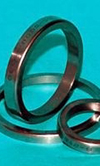Emerging Materials
 The field of materials and metallurgy has a big role to play in racing engine design, especially in those categories where the regulations allow emerging materials to be used. Unfortunately Formula One is now very limited in this respect and, before engine development was frozen, people worked hard and spent lots of money to get materials close to the imposed limits, especially the specific modulus rule where a maximum of 40GPa g-1 cm3 applies to metallic materials. There is always a push for increasing specific modulus (stiffness), and there exist numerous materials
The field of materials and metallurgy has a big role to play in racing engine design, especially in those categories where the regulations allow emerging materials to be used. Unfortunately Formula One is now very limited in this respect and, before engine development was frozen, people worked hard and spent lots of money to get materials close to the imposed limits, especially the specific modulus rule where a maximum of 40GPa g-1 cm3 applies to metallic materials. There is always a push for increasing specific modulus (stiffness), and there exist numerous materials
on the market which fall foul of this rule, and not all are produced by the route of ceramic reinforcement which was talked about in last month’s article on the subject. Certainly there are a number of companies producing aluminium alloys by novel methods which have a modulus much greater than the 70GPa that we would generally expect for such materials.
These high stiffness aluminium materials have found applications for both highly-loaded components such as pistons and for structural components to stiffen the entire engine structure. Increasing engine stiffness always seemed to be a popular idea with the chassis designers and a simple material substitution provided a useful increase in overall chassis stiffness as a result. The downside of the very high stiffness materials seemed to be very low elongation resulting in some expensive piston failures. However, newer materials are being developed which seek to address this problem, but Formula One is no longer in a position to help with materials development in this area.
I would like briefly to return to the subject of MMC materials, and specifically the ceramic reinforced metals. The illegality of the ceramic particulate reinforced materials is covered by rule 5.12.5 - a particular clause in the regulations which seems open to question:
“Metal Matrix Composites (MMC’s) – These are composite materials with a metallic matrix containing a phase of greater than 2%v/v which is not soluble in the liquid phase of the metallic matrix.”
I questioned this rule at the time with the team that I worked for, and an eminent professor of materials thought that this rule was written in a way that would allow a lot of MMCs to be used. There are specific classes of MMC materials that would definitely pass this rule and perhaps some of these are being used presently although I have heard nothing to make me think that they are. However, engine manufacturers are notoriously secretive about any competitive advantage they might have!
However, there were some very interesting material developments which did at least make it as far as engine testing if not into races. Without going into too much detail, I can say that carbon-fibre reinforced plastic (CFRP) connecting rods have been tried by at least one engine manufacturer in the past. My understanding is that these were pretty unsuccessful, but there is some anecdotal evidence that they were run at a race meeting in practice, if not in a race.
MMC materials in the form of ceramic reinforced steels were tested very successfully as gudgeon pins within the specific stiffness rule. There is also some evidence to suggest that MMC titanium has been successfully tested and possibly raced before the specific modulus rule was imposed. There has been an unsuccessful attempt in the past to run an aluminium MMC inlet valve in an Formula One engine, but this was a step too far! This is certainly not an exhaustive list of components tested and raced using novel materials, but does give a flavour of what went on when engineers and materials scientists were given a free rein.
For rotating and reciprocating components in an engine there is great merit in reducing component mass. This leads not only to lower loads but also better control of the valvetrain for instance. Whilst there are commercially available low-density tool steels (up to 10% less dense than conventional steels), these weren’t developed with the express aim of low density, but were exploited for highly-stressed engine components. Some of these also possess slightly increased modulus compared to general steel materials.
It is my hope that when the FIA release the new engine rules, that they allow materials development to resume (within a cost cap if necessary). Racing and Formula One has been at the forefront of development of materials and processes which are now used on passenger vehicles, and the benefits of a very light engine are not to be ignored in the field of road vehicle design.
Written by Wayne Ward.